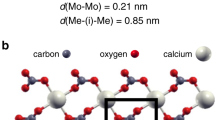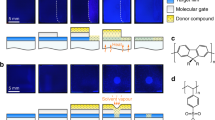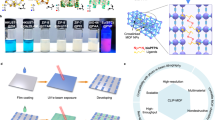Abstract
The design of networks of organic molecules at metal surfaces, highly attractive for a variety of applications ranging from molecular electronics to gas sensors to protective coatings, has matured to a degree that patterns with multinanometre unit cells and almost any arbitrary geometry can be fabricated. This Review provides an overview of vacuum-deposited organic networks at metal surfaces, using intermolecular hydrogen bonding, metal–atom coordination and in situ polymerization. Recent progress in these areas highlights how the design of surface patterns can benefit from the wealth of information available from solution- and bulk-phase chemistry, while at the same time providing novel insights into the nature of such bonds through the applicability of direct scanning probe imaging at metal surfaces.
This is a preview of subscription content, access via your institution
Access options
Subscribe to this journal
Receive 12 print issues and online access
$259.00 per year
only $21.58 per issue
Buy this article
- Purchase on Springer Link
- Instant access to full article PDF
Prices may be subject to local taxes which are calculated during checkout








Similar content being viewed by others
References
Lindsay, S. M. & Ratner, M. A. Molecular transport junctions: Clearing mists. Adv. Mater. 19, 23–31 (2007).
Green, J. E. et al. A 160-kilobit molecular electronic memory patterned at 1011 bits per square centimetre. Nature 445, 414–417 (2007).
Liu, Z., Yasseri, A., Lindsey, J. & Bocian, D. Molecular memories that survive silicon device processing and real-world operation. Science 302, 1543–1545 (2003).
Bohrer, F. I. et al. Comparative gas sensing in cobalt, nickel, copper, zinc, and metal-free phthalocyanine chemiresistors. J. Am. Chem. Soc. 131, 478–485 (2009).
Cody, I. A. et al. Low energy surfaces for reduced corrosion and fouling. US patent 0219598 A1 (2005).
Bhushan, B. Nanotribology and nanomechanics in nano/biotechnology. Phil. Trans. R. Soc. A 366, 1499–1537 (2008).
Kind, M. & Woll, C. Organic surfaces exposed by self-assembled organothiol monolayers: Preparation, characterization, and application. Prog. Surf. Sci. 84, 230–278 (2009).
Lauhon, L. & Ho, W. Single-molecule chemistry and vibrational spectroscopy: Pyridine and benzene on Cu(001). J. Phys. Chem. A 104, 2463–2467 (2000).
Lukas, S., Witte, G. & Woll, C. Novel mechanism for molecular self-assembly on metal substrates: Unidirectional rows of pentacene on Cu(110) produced by a substrate-mediated repulsion. Phys. Rev. Lett. 88, 028301 (2002).
Wan, L. J. & Itaya, K. In situ scanning tunnelling microscopy of benzene, naphthalene, and anthracene adsorbed on Cu(111) in solution. Langmuir 13, 7173–7179 (1997).
Dougherty, D. B., Maksymovych, P., Lee, J. & Yates, J. T. Local spectroscopy of image-potential-derived states: From single molecules to monolayers of benzene on Cu(111). Phys. Rev. Lett. 97, 236806 (2006).
Weiss, P. & Eigler, D. Site dependence of the apparent shape of a molecule in scanning tunneling microscopy images - benzene on Pt(111). Phys. Rev. Lett. 71, 3139–3142 (1993).
Mate, C. M. & Somorjai, G. A. Carbon-monoxide induced ordering of benzene on Pt (111) and Rh (111) crystal-surfaces. Surf. Sci. 160, 542–560 (1985).
Han, P., Mantooth, B., Sykes, E., Donhauser, Z. & Weiss, P. Benzene on Au {111} at 4 K: Monolayer growth and tip-induced molecular cascades. J. Am. Chem. Soc. 126, 10787–10793 (2004).
Mantooth, B. A. et al. Analyzing the motion of benzene on Au{111}: Single molecule statistics from scanning probe images. J. Phys. Chem. C 111, 6167–6182 (2007).
Chiang, S., Wilson, R. J., Mate, C. M. & Ohtani, H. Real space imaging of Co-adsorbed Co and benzene molecules on Rh(111). J. Microsc-Oxford 152, 567–571 (1988).
Hallmark, V. M., Chiang, S., Brown, J. K. & Woll, C. Real-space imaging of the molecular-organization of naphthalene on Pt(111). Phys. Rev. Lett. 66, 48–51 (1991).
Sohnchen, S., Lukas, S. & Witte, G. Epitaxial growth of pentacene films on Cu(110). J. Chem. Phys. 121, 525–534 (2004).
Xi, M., Yang, M. X., Jo, S. K., Bent, B. E. & Stevens, P. Benzene adsorption on Cu(111) - formation of a stable bilayer. J. Chem. Phys. 101, 9122–9131 (1994).
Lauhon, L. & Ho, W. Electronic and vibrational excitation of single molecules with a scanning tunneling microscope. Surf. Sci. 451, 219–225 (2000).
Hla, S., Bartels, L., Meyer, G. & Rieder, K. Inducing all steps of a chemical reaction with the scanning tunneling microscope tip: Towards single molecule engineering. Phys. Rev. Lett. 85, 2777–2780 (2000).
McCarty, G. & Weiss, P. Footprints of a surface chemical reaction: Dissociative chemisorption of p-diiodobenzene on Cu{111}. J. Phys. Chem. B 106, 8005–8008 (2002).
Berland, K., Einstein, T. L. & Hyldgaard, P. Rings sliding on a honeycomb network: Adsorption contours, interactions, and assembly of benzene on Cu(111). Phys. Rev. B 80, 155431 (2009).
Sautet, P. & Bocquet, M. L. A theoretical-analysis of the site dependence of the shape of a molecule in STM images. Surf. Sci. 304, L445–L450 (1994).
Wong, K., Kwon, K., Rao, B., Liu, A. & Bartels, L. Effect of halo substitution on the geometry of arenethiol films on Cu(111). J. Am. Chem. Soc. 126, 7762–7763 (2004).
Bohringer, M., Morgenstern, K., Schneider, W. & Berndt, R. Separation of a racemic mixture of two-dimensional molecular clusters by scanning tunneling microscopy. Angew. Chem. Int. Ed. 38, 821–823 (1999).
Morgenstern, K., Hla, S. & Rieder, K. Coexisting superstructures of iodobenzene on Cu(111) near saturation coverage. Surf. Sci. 523, 141–150 (2003).
Lee, A. F., Chang, Z. P., Hackett, S. F. J., Newman, A. D. & Wilson, K. Hydrodebromination of bromobenzene over Pt(111). J. Phys. Chem. C 111, 10455–10460 (2007).
Xu, B., Tao, C. G., Williams, E. D. & Reutt-Robey, J. E. Coverage dependent supramolecular structures: C60:ACA monolayers on Ag(111). J. Am. Chem. Soc. 128, 8493–8499 (2006).
Liljeroth, P., Repp, J. & Meyer, G. Current-induced hydrogen tautomerization and conductance switching of naphthalocyanine molecules. Science 317, 1203–1206 (2007).
Repp, J., Meyer, G., Stojkovic, S. M., Gourdon, A. & Joachim, C. Molecules on insulating films: Scanning-tunneling microscopy imaging of individual molecular orbitals. Phys. Rev. Lett. 94, 026803 (2005).
Nilekar, A. U., Greeley, J. & Mavrikakis, M. A simple rule of thumb for diffusion on transition-metal surfaces. Angew. Chem. Int. Ed. 45, 7046–7049 (2006).
Wong, K., Kwon, K. Y. & Bartels, L. Surface dynamics of benzenethiol molecules. Appl. Phys. Lett. 88, 183106 (2006).
Guo, X. F. et al. Covalently bridging gaps in single-walled carbon nanotubes with conducting molecules. Science 311, 356–359 (2006).
Kiguchi, M. et al. Highly conductive molecular junctions based on direct binding of benzene to platinum electrodes. Phys. Rev. Lett. 101, 046801 (2008).
Sykes, E., Han, P., Kandel, S., Kelly, K., McCarty, G. & Weiss, P. Substrate-mediated interactions and intermolecular forces between molecules adsorbed on surfaces. Acc. Chem. Res. 36, 945–953 (2003).
Pawin, G., Wong, K. L., Kwon, K. Y. & Bartels, L. A homomolecular porous network at a Cu(111) surface. Science 313, 961–962 (2006).
Stranick, S. J., Kamna, M. M. & Weiss, P. S. Atomic-scale dynamics of a 2-dimensional gas-solid interface. Science 266, 99–102 (1994).
Rao, B., Kwon, K., Zhang, J., Liu, A. & Bartels, L. Low-temperature mobility and structure formation of a prochiral aromatic thiol (2,5-dichlorothiophenol) on Cu(111). Langmuir 20, 4406–4412 (2004).
Blunt, M. O. et al. Random tiling and topological defects in a two-dimensional molecular network. Science 322, 1077–1081 (2008).
Moessner, R., Sondhi, S. L. & Fradkin, E. Short-ranged resonating valence bond physics, quantum dimer models, and Ising gauge theories. Phys. Rev. B 65, 024504 (2002).
Otero, R. et al. Elementary structural motifs in a random network of cytosine adsorbed on a gold(111) surface. Science 319, 312–315 (2008).
Heinrich, A., Lutz, C., Gupta, J. & Eigler, D. Molecule cascades. Science 298, 1381–1387 (2002).
Kuhnle, A., Linderoth, T., Hammer, B. & Besenbacher, F. Chiral recognition in dimerization of adsorbed cysteine observed by scanning tunnelling microscopy. Nature 415, 891–893 (2002).
Barlow, S. M. et al. Polymorphism in supramolecular chiral structures of R- and S-alanine on Cu(110). Surf. Sci. 590, 243–263 (2005).
Rothemund, P. W. K. Folding DNA to create nanoscale shapes and patterns. Nature 440, 297–302 (2006).
Theobald, J. A., Oxtoby, N. S., Phillips, M. A., Champness, N. R. & Beton, P. H. Controlling molecular deposition and layer structure with supramolecular surface assemblies. Nature 424, 1029–1031 (2003).
Perdigao, L. M. A. et al. Bimolecular networks and supramolecular traps on Au(111). J. Phys. Chem. B 110, 12539–12542 (2006).
Zhang, H. M. et al. One-step preparation of large-scale self-assembled monolayers of cyanuric acid and melamine supramolecular species on Au(111) surfaces. J. Phys. Chem. C 112, 4209–4218 (2008).
Yokoyama, T., Yokoyama, S., Kamikado, T., Okuno, Y. & Mashiko, S. Selective assembly on a surface of supramolecular aggregates with controlled size and shape. Nature 413, 619–621 (2001).
Pawin, G. et al. Surface coordination network based on substrate-derived metal adatoms with local charge excess. Angew. Chem. Int. Ed. 47, 8442–8445 (2008).
Bohringer, M. et al. Two-dimensional self-assembly of supramolecular clusters and chains. Phys. Rev. Lett. 83, 324–327 (1999).
Breitruck, A., Hoster, H. E., Meier, C., Ziener, U. & Behm, R. J. Interaction of Cu atoms with ordered 2D oligopyridine networks. Surf. Sci. 601, 4200–4205 (2007).
Schlickum, U. et al. Chiral kagome lattice from simple ditopic molecular bricks. J. Am. Chem. Soc. 130, 11778–11782 (2008).
Pawin, G. et al. A quantitative approach to hydrogen bonding at a metal surface. J. Am. Chem. Soc. 129, 12056–12057 (2007).
Kwon, K. Y. et al. H-atom position as pattern-determining factor in arenethiol films. J. Am. Chem. Soc. 131, 5540–5545 (2009).
Chen, W. et al. Two-dimensional pentacene: 3,4,9,10-perylenetetracarboxylic dianhydride supramolecular chiral networks on Ag(111). J. Am. Chem. Soc. 130, 12285–12289 (2008).
Schnadt, J. et al. Extended one-dimensional supramolecular assembly on a stepped surface. Phys. Rev. Lett. 100, 046103 (2008).
Otero, R. et al. Guanine quartet networks stabilized by cooperative hydrogen bonds. Angew. Chem. Int. Ed. 44, 2270–2275 (2005).
Tait, S. L. et al. Assembling isostructural metal-organic coordination architectures on Cu(100), Ag(100) and Ag(111) substrates. Chem. Phys. Chem. 9, 2495–2499 (2008).
Schickum, U. et al. Metal-organic honeycomb nanomeshes with tunable cavity size. Nano Lett. 7, 3813–3817 (2007).
Kuhne, D. et al. High-quality 2D metal-organic coordination network providing giant cavities within mesoscale domains. J. Am. Chem. Soc. 131, 3881–3883 (2009).
Lin, N., Dmitriev, A., Weckesser, J., Barth, J. V. & Kern, K. Real-time single-molecule imaging of the formation and dynamics of coordination compounds. Angew. Chem. Int. Ed. 41, 4779–4783 (2002).
Langner, A., Tait, S. L., Lin, N., Rajadurai, C., Ruben, M. & Kern, K. Self-recognition and self-selection in multicomponent supramolecular coordination networks on surfaces. Proc. Natl Acad. Sci. USA 104, 17927–17930 (2007).
Stepanow, S. et al. Surface-assisted assembly of 2D metal-organic networks that exhibit unusual threefold coordination symmetry. Angew. Chem. Int. Ed. 46, 710–713 (2007).
Jensen, S. & Baddeley, C. J. Formation of PTCDI-based metal organic structures on a Au(111) surface modified by 2-D Ni clusters. J. Phys. Chem. C 112, 15439–15448 (2008).
Dmitriev, A., Spillmann, H., Lin, N., Barth, J. V. & Kern, K. Modular assembly of two-dimensional metal-organic coordination networks at a metal surface. Angew. Chem. Int. Ed. 42, 2670–2673 (2003).
Langner, A., Tait, S. L., Lin, N., Chandrasekar, R., Ruben, M. & Kern, K. Ordering and stabilization of metal-organic coordination chains by hierarchical assembly through hydrogen bonding at a surface. Angew. Chem. Int. Ed. 47, 8835–8838 (2008).
Venkataraman, D., Du, Y. H., Wilson, S. R., Hirsch, K. A., Zhang, P. & Moore, J. S. A coordination geometry table of the d-block elements and their ions. J. Chem. Educ. 74, 915–918 (1997).
Seitsonen, A. P. et al. Density functional theory analysis of carboxylate-bridged diiron units in two-dimensional metal-organic grids. J. Am. Chem. Soc. 128, 5634–5635 (2006).
Gourdon, A. On-surface covalent coupling in ultrahigh vacuum. Angew. Chem. Int. Ed. 47, 6950–6953 (2008).
Nyffenegger, R. M. & Penner, R. M. Nanometer-scale electropolymerization of aniline using the scanning tunneling microscope. J. Phys. Chem. 100, 17041–17049 (1996).
Ullmann, F., Meyer, G. M., Loewenthal, O. & Gilli, O. Ueber symmetrische biphenylderivate. Justus Liebig's Annalen der Chemie 331, 38 (1904).
Xi, M. & Bent, B. E. Mechanisms of the Ullmann coupling reaction in adsorbed monolayers. J. Am. Chem. Soc. 115, 7426–7433 (1993).
McCarty, G. S. & Weiss, P. S. Formation and manipulation of protopolymer chains. J. Am. Chem. Soc. 126, 16772–16776 (2004).
Grill, L., Dyer, M., Lafferentz, L., Persson, M., Peters, M. V. & Hecht, S. Nano-architectures by covalent assembly of molecular building blocks. Nature Nanotech. 2, 687–691 (2007).
Lafferentz, L., Ample, F., Yu, H., Hecht, S., Joachim, C. & Grill, L. Conductance of a single conjugated polymer as a continuous function of its length. Science 323, 1193–1197 (2009).
Lipton-Duffin, J. A., Ivasenko, O., Perepichka, D. F. & Rosei, F. Synthesis of polyphenylene molecular wires by surface-confined polymerization. Small 5, 592–597 (2009).
Weigelt, S. et al. Covalent interlinking of an aldehyde and an amine on a Au(111) surface in ultrahigh vacuum. Angew. Chem. Int. Ed. 46, 9227–9230 (2007).
Treier, M., Richardson, N. V. & Fasel, R. Fabrication of surface-supported low-dimensional polyimide networks. J. Am. Chem. Soc. 130, 14054–14055 (2008).
Boz, S., Stohr, M., Soydaner, U. & Mayor, M. Protecting-group-controlled surface chemistry - organization and heat-induced coupling of 4,4′-di(tert-butoxycarbonylamino)biphenyl on metal surfaces. Angew. Chem. Int. Ed. 48, 3179–3183 (2009).
Zwaneveld, N. A. A. et al. Organized formation of 2D extended covalent organic frameworks at surfaces. J. Am. Chem. Soc. 130, 6678–6679 (2008).
Matena, M., Riehm, T., Stohr, M., Jung, T. A. & Gade, L. H. Transforming surface coordination polymers into covalent surface polymers: Linked polycondensed aromatics through oligomerization of N-heterocyclic carbene intermediates. Angew. Chem. Int. Ed. 47, 2414–2417 (2008).
Veld, M. I., Iavicoli, P., Haq, S., Amabilino, D. B. & Raval, R. Unique intermolecular reaction of simple porphyrins at a metal surface gives covalent nanostructures. Chem. Comm. 1536–1538 (2008).
N'Diaye, A. T., Bleikamp, S., Feibelman, P. J. & Michely, T. Two-dimensional Ir cluster lattice on a graphene moire on Ir(111). Phys. Rev. Lett. 97, 215501 (2006).
Clair, S., Pons, W., Brune, H., Kern, K. & Barth, J. V. Mesoscopic metallosupramolecular texturing by hierarchic assembly. Angew. Chem. Int. Ed. 44, 7294–7297 (2005).
Hatzor, A. & Weiss, P. Molecular rulers for scaling down nanostructures. Science 291, 1019–1020 (2001).
Yoshimoto, S. et al. Epitaxial supramolecular assembly of fullerenes formed by using a coronene template on a Au(111) surface in solution. J. Am. Chem. Soc. 129, 4366–4376 (2007).
Saywell, A. et al. Electrospray deposition of C-60 on a hydrogen-bonded supramolecular network. J. Phys. Chem. C 112, 7706–7709 (2008).
Madueno, R., Raisanen, M. T., Silien, C. & Buck, M. Functionalizing hydrogen-bonded surface networks with self-assembled monolayers. Nature 454, 618–621 (2008).
Stepanow, S. et al. Steering molecular organization and host-guest interactions using two-dimensional nanoporous coordination systems. Nature Mater. 3, 229–233 (2004).
Stepanow, S., Lin, N., Barth, J. V. & Kern, K. Non-covalent binding of fullerenes and biomolecules at surface-supported metallosupramolecular receptors. Chem. Comm. 2153–2155 (2006).
Decker, R. et al. Using metal-organic templates to steer the growth of Fe and Co nanoclusters. Appl. Phys. Lett. 93, 243102 (2008).
Schiffrin, A. et al. Self-aligning atomic strings in surface-supported biomolecular gratings. Phys. Rev. B 78, 035424 (2008).
Horvath, J. D., Koritnik, A., Kamakoti, P., Sholl, D. S. & Gellman, A. J. Enantioselective separation on a naturally chiral surface. J. Am. Chem. Soc. 126, 14988–14994 (2004).
Zaera, F. Chiral modification of solid surfaces: A molecular view. J. Phys. Chem. C 112, 16196–16203 (2008).
Humblot, V., Lorenzo, M. O., Baddeley, C. J., Haq, S. & Raval, R. Local and global chirality at surfaces: Succinic acid versus tartaric acid on Cu(110). J. Am. Chem. Soc. 126, 6460–6469 (2004).
Spillmann, H., Dmitriev, A., Lin, N., Messina, P., Barth, J. V. & Kern, K. Hierarchical assembly of two-dimensional homochiral nanocavity arrays. J. Am. Chem. Soc. 125, 10725–10728 (2003).
Weckesser, J., De Vita, A., Barth, J. V., Cai, C. & Kern, K. Mesoscopic correlation of supramolecular chirality in one-dimensional hydrogen-bonded assemblies. Phys. Rev. Lett. 87, 096101 (2001).
Collman, J. P., Zhang, X. M., Lee, V. J., Uffelman, E. S. & Brauman, J. I. Regioselective and enantioselective epoxidation catalyzed by metalloporphyrins. Science 261, 1404–1411 (1993).
Acknowledgements
The author's work on this review was supported by the US Department of Energy under Grant No. DE-FG02-03ER15464 and by the National Science Foundation under Grant No. CHE-0647152.
Author information
Authors and Affiliations
Rights and permissions
About this article
Cite this article
Bartels, L. Tailoring molecular layers at metal surfaces. Nature Chem 2, 87–95 (2010). https://doi.org/10.1038/nchem.517
Published:
Issue Date:
DOI: https://doi.org/10.1038/nchem.517
This article is cited by
-
Toward conformational identification of molecules in 2D and 3D self-assemblies on surfaces
Communications Chemistry (2023)
-
Ordering a rhenium catalyst on Ag(001) through molecule-surface step interaction
Communications Chemistry (2022)
-
Electronic structures and optical characteristics of fluorescent pyrazinoquinoxaline assemblies and Au interfaces
Scientific Reports (2021)
-
Initiating Ullmann-like coupling of Br2Py by a semimetal surface
Scientific Reports (2021)
-
Tailoring atomic layer growth at the liquid-metal interface
Nature Communications (2018)



